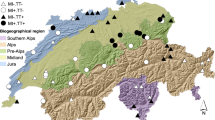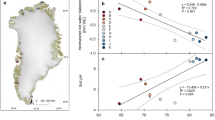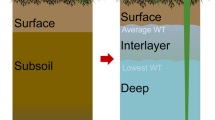Abstract
Studies and models of trace-gas flux in the Arctic consider temperature and moisture to be the dominant controls over land–atmosphere exchange1,2, with little attention having been paid to the effects of different substrates. Likewise, current Arctic vegetation maps for models of vegetation change recognize one or two tundra types3,4 and do not portray the extensive regions with different soils within the Arctic. Here we show that rapid changes to ecosystem processes (such as photosynthesis and respiration) that are related to changes in climate and land usage will be superimposed upon and modulated by differences in substrate pH. A sharp soil pH boundary along the northern front of the Arctic Foothills in Alaska separates non-acidic (pH > 6.5) ecosystems to the north from predominantly acidic (pH < 5.5) ecosystems to the south. Moist non-acidic tundra has greater heat flux, deeper summer thaw (active layer), is less of a carbon sink, and is a smaller source of methane than moist acidic tundra.
This is a preview of subscription content, access via your institution
Access options
Subscribe to this journal
Receive 51 print issues and online access
$199.00 per year
only $3.90 per issue
Buy this article
- Purchase on Springer Link
- Instant access to full article PDF
Prices may be subject to local taxes which are calculated during checkout

Similar content being viewed by others
References
Rastetter, E. B., McKane, R. B., Shaver, G. R., Nadelhoffer, K. J. & Giblin, A. in Global Change and Arctic Terrestrial Ecosystems (eds Oechel, W. C. et al.) 437–451 (Springer, New York, (1997)).
Vourlitis, G. L. & Oechel, W. C. in Global Change and Arctic Terrestrial Ecosystems (eds Oechel, W. C. et al.) 266–289 (Springer, New York, (1997)).
Lynch, A., Chapman, W., Walsh, J. & Weller, G. Development of a regional climate model of the Western Arctic. J. Clim. 8, 1556–1570 (1995).
Prentice, I. C.et al. Aglobal biome model based on plant physiology and dominance, soil properties and climate. J. Biogeogr. 19, 117–134 (1992).
Weller, G.et al. The Arctic Flux Study: a regional view of trace gas release. J. Biogeogr. 22, 365–374 (1995).
Muller, S. V.et al. Accuracy assessment of a land-cover map of the Kuparuk River basin, Alaska: Considerations for remote regions. Photogram. Eng. Remote Sens. (in the press).
Walker, D. A. & Everett, K. R. Loess ecosystems of northern Alaska: regional gradient and toposequence at Prudhoe Bay. Ecol. Monogr. 61, 437–464 (1991).
Walker, M. D., Walker, D. A. & Auerbach, N. A. Plant communities of a tussock tundra landscape in the brooks Range Foothills, Alaska. J. Veg. Sci. 5, 843–866 (1994).
Walker, D. A., Auerbach, N. A. & Shippert, M. M. NDVI, biomass, and landscape evolution of glaciated terrain in northern Alaska. Polar Rec. 31, 169–178 (1995).
Bockheim, J. G., Walker, D. A. & Everett, L. R. in Advances of Soil Science. Proc. Int. Symp. Carbon Sequestration in Soil (eds Lal, R., Kimble, J. M., Follett, R. F. & Stewart, B. A.) 143–155 (CRC Press, Boca Raton, FL, (1996)).
Michaelson, G. J., Ping, C. L. & Kimble, J. M. Carbon storage and distribution in tundra soils of Arctic Alaska, U.S.A. Arct. Alp. Res. 28, 414–424 (1996).
Matveyeva, N. V. Zonation in Plant Cover of the Arctic (Russian Academy of Sciences, Proceedings of the Komarov Botanical Institute, No. 21, (1998)).
Washburn, A. L. Geocryology: A Survey of Periglacial Processes and Environments (Halsted/Wiley, New York, (1980)).
Bockheim, J. G., Walker, D. A., Everett, L. R., Nelson, F. E. & Shiklomanov, N. I. Soils and cryoturbation in moist nonacidic and acidic tundra in the Kuparuk river basin, arctic Alaska, U.S.A. Arct. Alp. Res.(in the press).
Ebersole, J. J. Vegetation Disturbance and Recovery at the Oumalik Oil Well, Arctic Coastal Plain, Alaska. Thesis, Univ. Colorado, Boulder (1985).
Walker, D. A.et al. Landsat-assisted Environmental Mapping in the Arctic National Wildlife Refuge, Alaska (U.S. Army Cold Regions Research and Engineering Laboratory, Hanover, NH, CRREL Report 82-37, (1982)).
Carter, L. D. APleistocene sand sea on the Alaskan Arctic Coastal Plain. Science 211, 381–383 (1981).
Zhang, T., Osterkamp, T. E. & Stamnes, K. Some characteristics of the climate in Northern Alaska, U.S.A. Arct. Alp. Res. 28, 509–518 (1996).
Shippert, M., Walker, D. A., Auerbach, N. A. & Lewis, B. E. Biomass and leaf-area index maps derived from SPOT images for Toolik Lake and Imnavait Creek areas, Alaska. Polar Rec. 31, 147–154 (1995).
Benninghhoff, W. S. Interaction of vegetation and soil frost phenomena. Arctic 5, 34–44 (1952).
Heinselman, M. L. Landscape evolution, peatland types, and the environment in the Lake Agassiz Peatlands Natural Area, Minnesota. Ecol. Monogr. 40, 235–261 (1970).
Sjörs, H. Divergent succession in mires, a comparative study. Aquilo Ser. Bot. 28, 67–77 (1990).
Klinger, L. F. Coupling of soils and vegetation in peatland succession. Arct. Alp. Res. 28, 380–387 (1996).
Nelson, F. E.et al. Estimating active-layer thickness over large regions: Kuparuk River Basin, Alaska. Arct. Alp. Res. 29, 367–378 (1997).
Eugster, W., McFadden, J. P. & Chapin, F. S. I. Acomparative approach to regional variation in surface fluxes using mobile eddy correlation towers. Boundary-Layer Meteorol. 85, 293–307 (1997).
Vourlitis, G. L. & Oechel, W. C. Landscape-scale CO2, H2O vapour and energy flux of moist-wet coastal tundra ecosystems over two growing seasons. J. Ecol. 85, 575–590 (1997).
Lemme, D., Ping, C. L. & Michaelson, G. J. Effect of temperature, soil, and permafrost on microbial respiration of CO2 from acidic and nonacidic tundra. LAII Science Workshop (LAII Science Mangement Office, University of Alaska Fairbanks, (1997)).
Oechel, W. C., Vourlitis, G. & Hastings, S. J. Cold-season CO2 emission from arctic soils. Global Biogeochem. Cycles 11, 163–172 (1997).
Bockheim, J. G. & Tarnocai, C. in Handbook of Soil Science (eds Sumner, M. E. et al.) (CRC Press, Boca Raton, FL, in the press).
Whalen, S. C. & Reeburgh, W. S. Amethane flux transect along the trans-Alaska pipeline haul road. Tellus 42B, 237–249 (1990).
Acknowledgements
The following US National Science Foundation projects contributed to this work: Arctic Transitions in the Land-Atmosphere System, the Flux Study, the Arctic Long-Term Ecology Research project, and the International Tundra Experiment. The US Department of Energy's Response, Resistance, Resilience, and Recovery of Arctic Ecosystems to Disturbance project also made significant contributions to the data used in the project.
Author information
Authors and Affiliations
Corresponding author
Rights and permissions
About this article
Cite this article
Walker, D., Auerbach, N., Bockheim, J. et al. Energy and trace-gas fluxes across a soil pH boundary in the Arctic. Nature 394, 469–472 (1998). https://doi.org/10.1038/28839
Received:
Accepted:
Issue Date:
DOI: https://doi.org/10.1038/28839
This article is cited by
-
Vegetation and hydrology stratification as proxies to estimate methane emission from tidal marshes
Biogeochemistry (2022)
-
Biophysical Determinants of Shifting Tundra Vegetation Productivity in the Beaufort Delta Region of Canada
Ecosystems (2022)
-
Biological chlorine cycling in the Arctic Coastal Plain
Biogeochemistry (2017)
-
Relationships Among pH, Minerals, and Carbon in Soils from Tundra to Boreal Forest Across Alaska
Ecosystems (2016)
-
Environmental and vegetation controls on the spatial variability of CH4 emission from wet-sedge and tussock tundra ecosystems in the Arctic
Plant and Soil (2015)
Comments
By submitting a comment you agree to abide by our Terms and Community Guidelines. If you find something abusive or that does not comply with our terms or guidelines please flag it as inappropriate.



